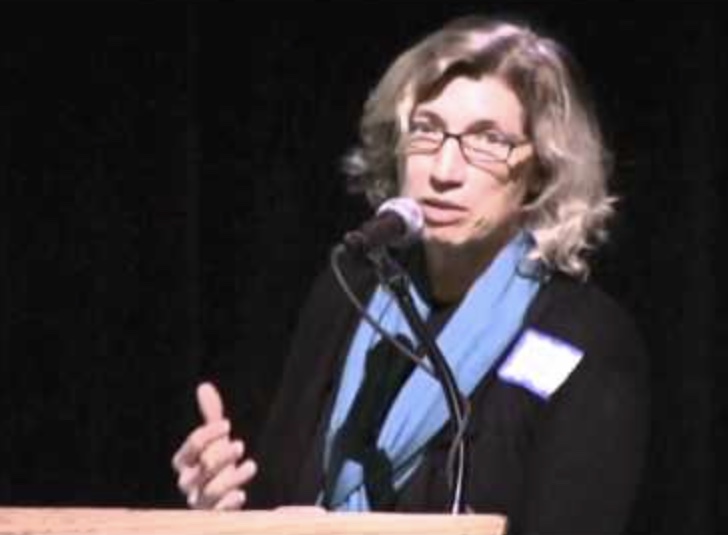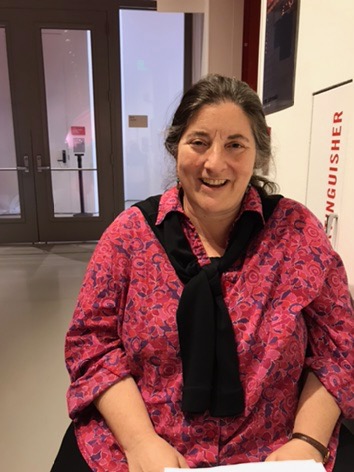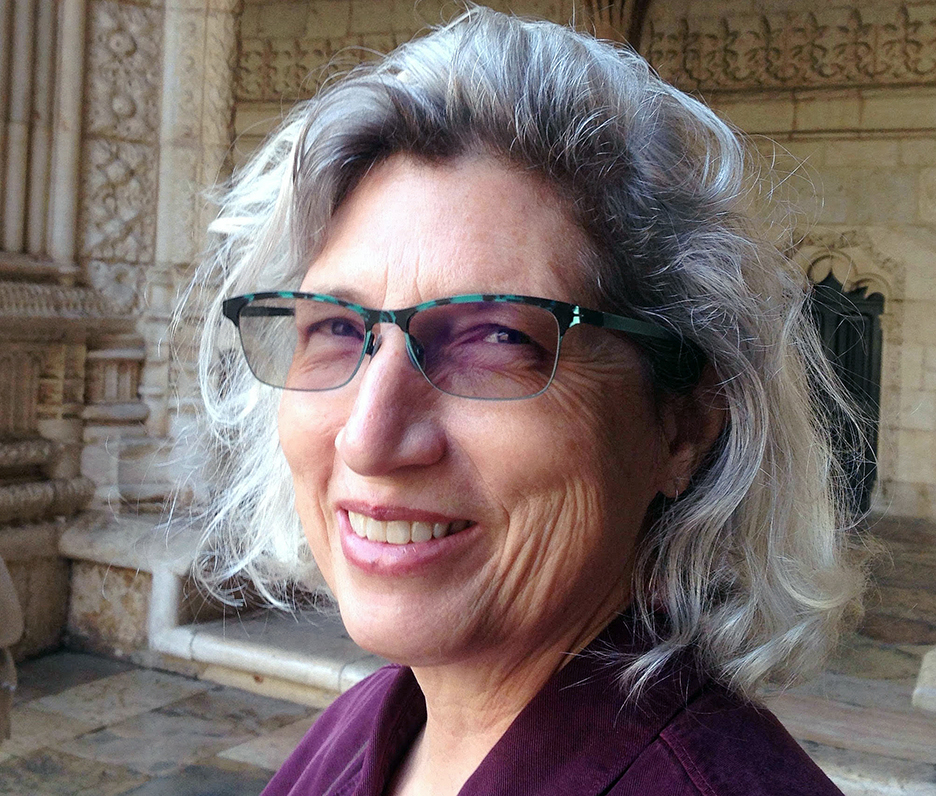The Bergman centennial has taught so much
Director Oxtoby and Professor Rugg helped me to comprehend and report on Bergman's centennial retrospective.
-
 Linda Rugg, now Associate Vice Chancellor for Research and professor in the Scandinavian Department at the University of California, Berkeley, allowed Ted Olsson to audit her semester class on Bergman’s films, which enhanced his critical appreciation and "as a mentor gave me a broader and deeper insight into the man and his films." Photo: youtube still from Crime and Detection in Scandinavian Literature
Linda Rugg, now Associate Vice Chancellor for Research and professor in the Scandinavian Department at the University of California, Berkeley, allowed Ted Olsson to audit her semester class on Bergman’s films, which enhanced his critical appreciation and "as a mentor gave me a broader and deeper insight into the man and his films." Photo: youtube still from Crime and Detection in Scandinavian Literature -
-
One hundred years ago, Ingmar Bergman was born in Uppsala to a chaplain of the royal family who exacted a strict discipline from his family. As a child Ingmar was versed in religion and ritual but isolated and amused by his imagination, which he expressed in his puppet theater and early film projector. As a man, he became known - apart from his profundity and prodigious productivity - for his amazing creativity in recasting autobiographical incidents and experiences into dramatic and exquisitely written films.
-
 Susan Oxtoby, executive director PFA, was perfect for selecting the yearlong program of films and visitor lectures by and about Bergman. She has an appreciation for his work in a very broad spectrum of international film artistry and history. Photo: Ted Olsson
Susan Oxtoby, executive director PFA, was perfect for selecting the yearlong program of films and visitor lectures by and about Bergman. She has an appreciation for his work in a very broad spectrum of international film artistry and history. Photo: Ted Olsson -
-
Retrospective in retrospect
I was acquainted with some but not many of Ingmar Bergman’s films, so I viewed this year’s centennial retrospective of his life and work as an opportunity to educate myself and inform readers about the legendary Swedish filmmaker.
When I was growing up, my father, Hugo Olsson, was editor and publisher of Vestkusten, the Bay Area’s local Swedish newspaper, which his father had founded. One night while I was in college, he took me to see a double billing of The Seventh Seal and The Virgin Spring. These medieval dramas were unlike any films I had ever seen, and I found the photography and dramas beautiful and memorable.
All these years later I am indebted to several people for the opportunity to acquaint myself with more of his work. This centennial year was my opportunity to see a broad selection of Bergman's nearly five dozen films, to select a dozen as favorites and a few as thought-provoking in their symbolism or technique.
I offer many thanks to mentors Susan Oxtoby, director of the Pacific Film Archive at the University of California, Berkeley and Linda Rugg, professor in the university’s Scandinavian Department and an authority on Bergman, among many other Scandinavian specialties. I am also indebted to others for contributing to my appreciation of Bergman: Richard Peterson, director of the California Film Institute in San Rafael, California; and above all, Swedish Consul General Barbro Osher, whose support of the show venues and their programs, but also specifically for arranging for me to interview the guests speakers from Sweden, deepened my understanding of Bergman, his art and his team. Barbro Osher is the benefactor for so much art and education here and throughout the nation.
To fully appreciate their devotion to this subject and their complementary partnership in this centennial, which made it so exemplary, I interviewed Susan and Linda. -
 Linda Rugg, now Associate Vice Chancellor for Research and professor in the Scandinavian Department at the University of California, Berkeley.
Linda Rugg, now Associate Vice Chancellor for Research and professor in the Scandinavian Department at the University of California, Berkeley. -
Susan Oxtoby grew up in Toronto where her father was a professor of comparative literature and her mother ran a film club for her brother’s junior high school; they were both cinefiles, so Susan and her brother became cinephiles, too.
Susan graduated from the University of Toronto with a degree in film. She ran the university’s film society and worked at the Cinematheque for a dozen years, eventually becoming its director. She was always impressed with the University of California, Berkeley’s Pacific Film Archive (PFA) and collaborated whenever possible. When PFA’s director retired in 2005, Susan became the new director.
In June 2015, SF (Swedish FilmIndustry, the national agency for promoting Sweden’s cinematic cultural heritage) approached Susan as a partner in this year’s global centennial of the birth of Ingmar Bergman: The exciting 2018 PFA program with 85 showings of Bergman’s 59 films would take more than a year of preparation. It involved not merely screening the films and featuring notable Swedish colleagues of Bergman and Svensk Filmindustri (SF) authorities, but also incorporating classes into the Scandinavian Department academic progam.
UC Berkeley’s PFA is part of the university’s Berkeley Art Museum and Pacific Film Archive (BAMPFA), a fruitful and collaborative partnership benefitting the whole Bay Area and a world leader in cinema archives. PFA’s retrospective, arranged thematically rather than chronologically, stretches across 11 months with printed guides for each. This means audiences gain a rewarding appreciation for Bergman whenever they attend; and guest speakers bring new insights to all the films. Because some Bergman viewers have regarded his films as dark and foreboding, if not forbidding, it is interesting to note how many new fans are discovering and appreciating him this year. The PFA viewings are frequently packed if not sold out. Susan Oxtoby believes much of this is due to Bergman’s genius not merely as an innovative film director but because of his lifetime work in, deep study of and love for theater, and because he authored almost all his films’ scripts, and collaborated with a trusted and proven troupe of actors who believed in him and trusted his aesthetic vision. Oxtoby admires Bergman for how he was able to continually develop the quality of his art in collaboration with his crew and actors due to their mutual trust and bond.
It is interesting to consider the freshmen students who sometimes prefer the “action” movies of current fare over the intensely subliminal conflicts of the characters and exquisite film techniques of Bergman’s psychological dramas. Some students are less interested or perhaps deflected by the autobiographical similarities of the films, or of the religious agony that haunted several of his early films. But many of today’s young adults find his themes rich and multifaceted while older viewers - who remember their reactions to the films’ debuts - are now particularly interested in his techniques and how well crafted the films are. Oxtoby has remarked upon how well his films hold up, further evidenced by this year’s attendance by old and young.
Oxtoby says Bergman creatively drew upon and transmuted his life experiences. His theater training and innovation forced him to find the best vehicles for expressing written words. And, one must acknowledge Swedish culture’s emphasis upon nature and location, which almost always has the force of a character in Bergman’s movies. -
Linda Rugg grew up in Nebraska and “became” Swedish not by heritage or marriage but by studying abroad. She returned to the U.S. to attend university and earned her PhD in comparative literature from Harvard. In her work on autobiographies, a chapter focused on August Strindberg, but she also included Bergman because so many of his films had autobiographical elements and he had published several memoirs. Her colleagues urged her to publish a book on the subject and she did.
Rugg taught for about 10 years at Ohio State University and never lectured on Bergman, but in 1999 she was hired by UC Berkeley’s Scandinavian Department. Her challenge became attracting students to study Bergman because of his themes and because his films were in black and white, when American films were in color. Even today some students can’t get past his focus on mundane affairs causing conflicts in the relationships between characters, revealing their psychological dramas.
To help them better understand his work, Rugg often describes Bergman’s Scandinavian heritage through Strindberg and Ibsen, for it is important that the students understand that Bergman was primarily a dedicated man of the theater, where the emphasis is upon expressing the word (the script).
As well-rounded students in art, science and technology, Rugg’s students pursue their careers in many fields but have an appreciation for and skill in interpreting great art. She too has been enriched by this breadth of learning and technology and has become an environmental humanist, particularly interested in ecology and culture, benefitting from both the Swedish and American points of view. Rugg also enjoys teaching Scandinavian crime fiction, where the emphasis is not merely upon entertainment but also the values inherent in that fictional universe and what those say about a society. And in teaching the history of the immigration of Scandinavians to the U.S., she is naturally concerned with contemporary race and immigration issues.
Rugg believes that as an auteur, playwright and director of classic films, Ingmar Bergman will be admired for his depth and insight, and remembered for the brutality of some of his themes or representations but particularly for the beauty of his depictions of people and nature (a very Swedish topic). Above all he will be admired for his aesthetic - in the staging, the photography, the lighting and sound qualities - as well as in his joyful collaboration with a most superb troupe of actors.
Rugg took a sabbatical in Sweden and attended Bergman conferences, but her main work was on a new project about two Swedish brothers who immigrated to Pennsylvania in 1722. One was a pastor; his younger brother, Gustavus Isellius, accompanied him and became an excellent artist, painting Native Americans with dignity. Stay tuned for her report on the fruition of this project. -
In retrospect
Over the course of this Bergman centennial year, I have come to revere Ingmar Bergman and identify favorites of my own. I have already confessed that The Seventh Seal and The Virgin Spring remain among my favorites, as do the films of the Silence Trilogy (Through a Glass Darkly, Winter Light and The Silence). The Hour of the Wolf and From the Lives of the Marionettes still puzzle me and though their themes are garish and nightmarish, I continue to be attracted to plumbing their symbolic meanings. I do enjoy his early work — including his “comedies” and “romances” of the 1940s and 1950s, and not merely to chart his own development. But his mature work, especially Cries and Whispers, The Magic Flute, Persona, and Fanny and Alexander are absolutely beloved favorites, though they might be difficult for initiates.
I am continually drawn to Bergman’s later work, for he was a filmmaker who never stopped inventing and an author who continually experimented. Of those I’ve seen so far, my favorites of his late works are: Autumn Sonata, Saraband, and even Faithless.
After immersing myself in Ingmar Bergman’s films, commentary, classes, books and visiting specialists, I am even more enthralled with him. This has only whet my appetite. While I love film and drama, I am particularly drawn to communication in the arts, specifically to the written word, which underlies literature and the performing arts, and at the end of this journey in December I will be much more interested in this subject than when I began. That is after all the purpose of both a college and a repertory theater; so I encourage you to patronize both and enjoy a Bergman film. -
Ted Olsson
-
-
